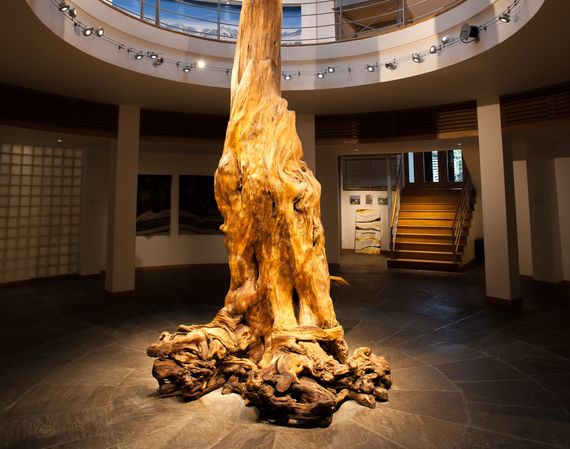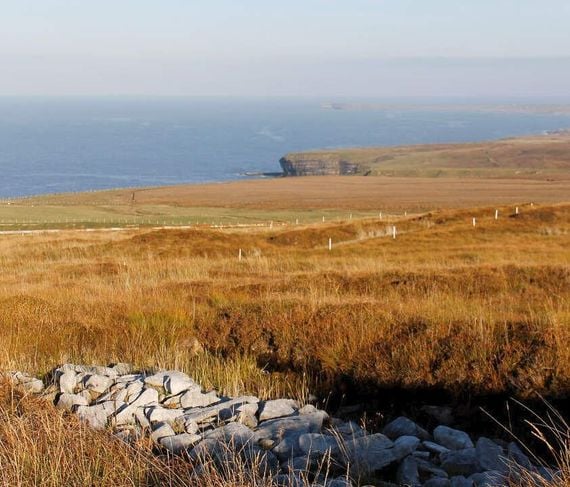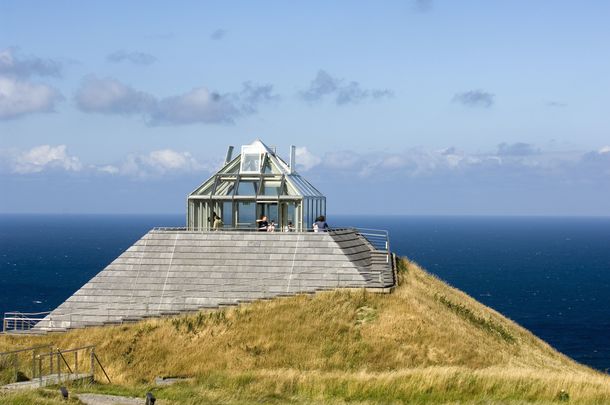Often the best feeling about traveling and exploring Ireland, for tourists and natives alike, is that sense of being surrounded by the ancient and being transported back through time.
Almost nowhere else in the country is this feeling as profound as when visiting the Céide Fields in Co. Mayo, the home of the oldest known field system in the world.
Located along stunning cliffs and looking straight out onto the Atlantic Ocean, the Céidé Fields (or Achaidh Chéide meaning “flat-topped hill fields”) is a remarkable neolithic site first discovered in the 1930s. At that time, the practice of cutting peat/turf from the bog into sods, and leaving it out to dry before being burnt to heat homes/water was still widely used in Belderrig, Co. Mayo. (Although many Irish people still cut turf, it is not as prevalent as it once was.)
It was while cutting turf that the local schoolmaster Patrick Caulfield first started coming across large numbers of stones deep down in the bog and as more were discovered, he realized that the stones appeared to be arranged in some kind of formation, not just by chance. Judging by the depth, he also believed that they must have been placed there well before the bog was formed.
In later years, his archaeologist son, Seamus Caulfield would return to the site of the stones to investigate further, discovering cultivated fields, houses, and tombs using iron probes normally employed for finding ancient trees under areas of deep bog.
Seaview at the Ceide Fields, County Mayo.
The farmland is believed to date back almost 6,000 years, the oldest of its kind in the world, and has greatly helped research of the Neolithic period circa 3,500 BC.
Since its discovery, an award-winning interpretive visitor center has been built near the site, featuring a 4,000-year-old ancient tree unearthed from the nearby bogland in the entrance hall, and the building itself has been heralded as a great piece of architecture that suits its rural environment.

Bog oak in the visitor's center. Credit: Tourism Ireland.
Within the center, you can take part in a tour, visit the tearooms, or even try your arm at discovering an ancient wall using the iron probe method undertaken by Dr. Caulfield and his team.
The beauty of the Ceide Fields is not just the incredible history but the surroundings within which you can witness this history, featuring dramatic 360-foot high cliffs and coastline and the natural wild ecology of blanket bog to also experience. The Céide Fields Center provides information on the formation of bog and its unique ecology from the way in which a subtle change in climate can bring it about to the birds, plants, and insects that reside there.

Are you planning a vacation in Ireland? Looking for advice or want to share some great memories? Join our Irish travel Facebook group.
The beauty of the North Mayo area was perfectly captured by none other than the late, great Irish poet Seamus Heaney. Accompanying a thank you letter after visiting the house of Patrick Caulfield in 1974, Heaney sent the poem “Belderg” in which he mentions that historic landmark and its imposing presence in the local countryside.

The Céide Fields. Credit: Tourism Ireland.
The three verses of the poem speaking most poignantly in the Céide Fields read:
“To lift the lid of the peat
And find this pupil dreaming
Of neolithic wheat!
When he stripped off blanket bog
The soft-piles centuries
“Fell open like a glib:
There were the first plough-marks,
The stone age fields, the tomb
Corbelled, turfed and chambered,
Floored with dry turf-coomb.
“A landscape fossilized,
Its stone wall patterings
Repeated before our eyes
In the stone walls of Mayo
Before I turn to go … “
Here's a short tourism video about the Ceide Fields and the coastal area surrounding them:
* Originally published May 2016, updated on Jan 2025.




Comments